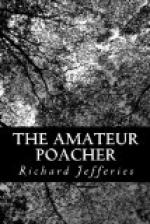The days go on and the hedges become green—the sun shines, and the blackbirds whistle in the trees. They leave the hedge, and mount into the elm or ash to deliver their song; then, after a pause, dive down again to the bushes. Up from the pale green corn that is yet but a few inches high rises a little brown bird, mounting till he has attained to the elevation of the adjacent oak. Then, beginning his song, he extends his wings, lifts his tail, and gradually descends slanting forward—slowly, like a parachute—sing, sing, singing all the while till the little legs, that can be seen against the sky somewhat depending, touch the earth and the wheat hides him. Still from the clod comes the finishing bar of his music.
In a short time up he rises again, and this time from the summit of his flight sinks in a similar manner singing to a branch of the oak. There he sings again; and, again rising, comes back almost to the same bough singing as he descends. But he is not alone: from an elm hard by come the same notes, and from yet another tree they are also repeated. They cannot rest—now one flits from the topmost bough of an elm to another topmost bough; now a second comes up from feeding, and cries from the branches. They are tree-pipits; and though the call is monotonous, yet it is so cheerful and pleasing that one cannot choose but stay and listen.
Suddenly, two that have been vigorously calling start forward together and meet in mid-air. They buffet each other with their wings; their little beaks fiercely strike; their necks are extended; they manoeuvre round each other, trying for an advantage. They descend, heedless in the rage of their tiny hearts, within a few yards of the watcher, and then in alarm separate. But one flies to the oak branch and defiantly calls immediately.
Over the meadows comes the distant note of the cuckoo. When he first calls his voice is short and somewhat rough, but in a few days it gains power. Then the second syllable has a mellow ring: and as he cries from the tree, the note, swiftly repeated and echoed by the wood, dwells on the ear something like the ‘hum’ or vibration of a beautiful bell.
As the hedges become green the ivy leaves turn brown at the edge and fall; the wild ivy is often curiously variegated. At the foot of the tree up which it climbs the leaves are five-angled, higher up they lose the angles and become rounded, though growing on the same plant. Sometimes they have a grey tint, especially those that trail along the bank; sometimes the leaves are a reddish brown with pale green ribs.
By the brook now the meadow has become of a rich bright green, the stream has sunk and is clear, and the sunlight dances on the ripples. The grasses at the edge—the turf—curl over and begin to grow down the steep side that a little while since was washed by the current. Where there is a ledge of mud and sand the yellow wagtail runs; he stands on a stone and jerks his tail.




